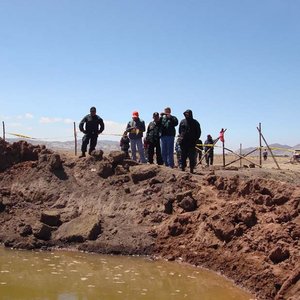Near-miss asteroid will return next year
When it whizzes past Earth in 2013, a newly discovered asteroid is going to miss our planet – but not by much. The 50 m space rock is expected to come closer than many satellites, highlighting the growing need to keep watch on hazards from above.
An amateur team discovered the unusual asteroid, dubbed 2012 DA14, on 22 February. Its small size and orbit meant that it was spotted only after it had flown past Earth at about seven times the distance of the Moon.
However, current predictions indicate that on its next flyby, due on 15 February 2013, it will pass Earth at just 24 000 km – closer than many commercial satellites.
"This is a safe distance, but it is still close enough to make the asteroid visible in normal binoculars," says Detlef Koschny, responsible for near-earth objects in ESA’s Space Situational Awareness (SSA) office.
Astronomers in Spain spot 'slippery target'
The asteroid was discovered by the La Sagra Sky Survey observatory, in the southeast of Spain, near Granada, at an altitude of 1700 m, one of the darkest, least light-polluted locations on the European mainland.
"Considering its path in the morning sky, its rather fast angular motion, the quite faint and fading brightness and its orbit high above the plane of Earth’s orbit, it was a slippery target – and easily could have escaped undetected during this Earth visit," says Jaime Nomen, one of the discoverers.

The team use several automated telescopes to scan the sky, and the discovery came somewhat serendipitously after they decided to search areas of the sky where asteroids are not usually seen.
"A preliminary orbit calculation shows that 2012 DA14 has a very Earth-like orbit with a period of 366.24 days, just one more day than our terrestrial year, and it 'jumps' inside and outside of the path of Earth two times per year," says Jaime.
While an impact with Earth has been ruled out on the asteroid’s next visit, astronomers will use that close approach for more studies and calculate the Earth and Moon’s gravitational effects on it.
"We will also be keen to see the asteroid’s resulting orbit after the next close approach in order to compute any future risk of impact," says Detlef.
Half a million undiscovered objects
The La Sagra Sky Survey is operated by the Observatorio Astronomico de Mallorca and has recently joined ESA’s SSA programme. In the future it will provide observations to the asteroid data hub that ESA is developing.
Together with information on space weather and debris, its information will help European scientists and policy-makers understand and assess hazards, particularly if an Earth-threatening asteroid is ever found.
The discovery of 2012 DA14 is particularly significant for the Agency’s SSA office, because it is typical of the estimated half a million undiscovered near-Earth objects up to 30 m across.
The goal is to be able to spot them at least three weeks before closest approach to Earth.
"We are developing a system of automated optical telescopes that can detect asteroids just like this one, with the goal of being able spot them at least three weeks before closest approach to Earth," says Detlef.
To achieve this, ESA specialists supported by European industry are planning a network of 1 m-diameter telescopes with a combined field of view large enough to image the complete sky in one night.
The work is continuing under the Agency’s Space Situational Awareness Preparatory Programme.















 Germany
Germany
 Austria
Austria
 Belgium
Belgium
 Denmark
Denmark
 Spain
Spain
 Estonia
Estonia
 Finland
Finland
 France
France
 Greece
Greece
 Hungary
Hungary
 Ireland
Ireland
 Italy
Italy
 Luxembourg
Luxembourg
 Norway
Norway
 The Netherlands
The Netherlands
 Poland
Poland
 Portugal
Portugal
 Czechia
Czechia
 Romania
Romania
 United Kingdom
United Kingdom
 Slovenia
Slovenia
 Sweden
Sweden
 Switzerland
Switzerland


































